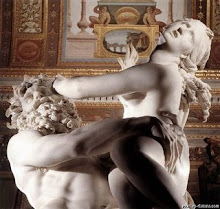skip to main |
skip to sidebar







 TENIERS, David the Younger
TENIERS, David the Younger
(b. 1610, Antwerpen, d. 1690, Bruxelles)
Biography
Prolific Flemish painter of the Baroque period known for his genre scenes of peasant life. He was the son and pupil of David Teniers the Elder. In 1637 he married Anna, daughter of the painter Jan Brueghel the Elder.
Teniers painted almost every kind of picture, but chiefly genre scenes of peasant life, many of which were subsequently used for tapestry designs in the 18th century. His early works in this vein show the influence of Adriaen Brouwer (e.g., Twelfth-night, Museo del Prado, Madrid). Many of his finer works date from 1640 to 1650. He was brilliant at handling crowd scenes in an open landscape and adept at characterizing his figures with a warm, human, and often humorous touch (e.g., The Village Fête, 1646; Hermitage, St. Petersburg). His landscape settings are atmospheric, and his still-life details precise. In the same decade he also painted a number of monumental processions (e.g., Procession of the Antwerp Civic Guards, 1643; Hermitage, St. Petersburg).
Teniers developed a second career in 1651 when he moved to Brussels, becoming court painter and keeper of the art collections to the regent of the Netherlands, the archduke Leopold William. He painted several views of the Archduke's picture gallery. He also made many small-scale individual copies of paintings in the Duke's collection by foreign artists, especially Italians. Of these, 244 were engraved in 1660 under the title Theatrum Pictorium. As a pictorial inventory of a great 17th-century collection, this book of engravings was unique in its time and still constitutes a valuable source for the art historian.
Teniers was also court painter to Don John of Austria, who succeeded the Archduke as regent in 1656, and was one of the prime movers in the foundation of the Brussels Academy of Fine Arts (1663) and subsequently the Academy in Antwerp (1665). Teniers' son, also named David (1638-85), often imitated his father's work. There are several of his altarpieces in churches in Belgium.
 TENIERS, David the Elder
TENIERS, David the Elder
(b. 1582, Antwerpen, d. 1649, Antwerpen)
Biography
David Teniers the Elder (David I) was a Flemish Late Mannerist painter, mainly of religious subjects, who worked in Antwerp. He may have been associated with Rubens before going to Rome, where he worked in the Elsheimer circle, c. 1600-05. He became a master in Antwerp in 1606, but was constantly in debt and was active mainly as a dealer in his last years. The working lives of David the Elder and his son David the Younger (David II) - by far the most famous of the family - overlapped in the 1630s, and it is not clear who painted certain pictures in that period; what is clear that many of the paintings ascribed to David I in the 19th century are by David II.
David Teniers the Elder
David Teniers
David Teniers The Elder
David Teniers the Elder
David Teniers, the Elder
CATHOLIC ENCYCLOPEDIA: David Teniers
David Teniers
Teniers, David
David Teniers the Elder
David Teniers



 TEMPEL, Abraham van den
TEMPEL, Abraham van den
(b. 1622/23, Leeuwarden, d. 1672, Amsterdam)
Biography
Dutch painter. He was the son of the Frisian painter and Mennonite minister Lambert Jacobsz.. He received his training in Amsterdam from Jacob Backer c. 1642-6, after which he took up residence in Leiden. He married there in 1648. The influence of Backer is evident in several of his early biblical and allegorical paintings, for instance in three allegories, including the Maiden of Leiden Crowned by Minerva, which he painted in 1650-51 for the Lakenhal (the Cloth Hall) in Leiden (all Leiden, Stedelijk Museum Lakenhal). He later turned primarily to portrait painting, of which there are several dozen surviving works dating from 1660, when he moved to Amsterdam, until his death. Good examples are the pendant portraits of the Leiden cloth-manufacturer Pieter de la Court and his second wife Catharina van der Voort (1667; Amsterdam, Rijksmuseum).
Van den Tempel also painted group portraits, such as that of Albertina Agnes van Nassau-Dietz and her Children (1668; Leeuwarden, Fries Museum) and the portrait of the Amsterdam merchant David Leeuw with his Wife and Children (1671; Amsterdam, Rijksmuseum). These handsome portraits show some influence of Bartholomeus van der Helst but nevertheless reflect his own slightly more sober style. His paintings are among the best Dutch portraits of the third quarter of the 17th century. His work is characterized by the combination of static poses and elegant execution of details, particularly in the rendering of textiles. Among his pupils were Frans van Mieris and Michiel van Musscher.
 TAMM, Franz Werner von
TAMM, Franz Werner von
(b. 1658, Hamburg, d. 1724, Wien)
Biography
German painter, active in Italy and Austria. He was first trained in Hamburg by Dietrich von Sosten (fl 1669; d 1695) and Johann Joachim Pfeiffer (1662-1701). Although he initially leant towards historical painting, later he painted only still-lifes. Resident in Rome from 1685 to 1695, he was introduced into the city's Flemish/Italian circle of artists by Gaspar van Wittel. He worked occasionally with Pieter van Bloemen and Carel van Vogelaer (1653-95), then became a follower of Carlo Maratti, who painted the figures in his still-lifes. Through Maratti he gained commissions from the Roman patrician families, and their patronage made him known in Spain, France, England and Germany.
Franz Werner Von Tamm
Franz Werner von Tamm
Franz Werner Von Tamm
Franz Werner von Tamm (1658 - 1724)
Franz Werner von Tamm
Franz Werner von Tamm
Franz Werner VON TAMM
FRANZ WERNER TAMM
VON TAMM Franz Werner













































.jpg)
















